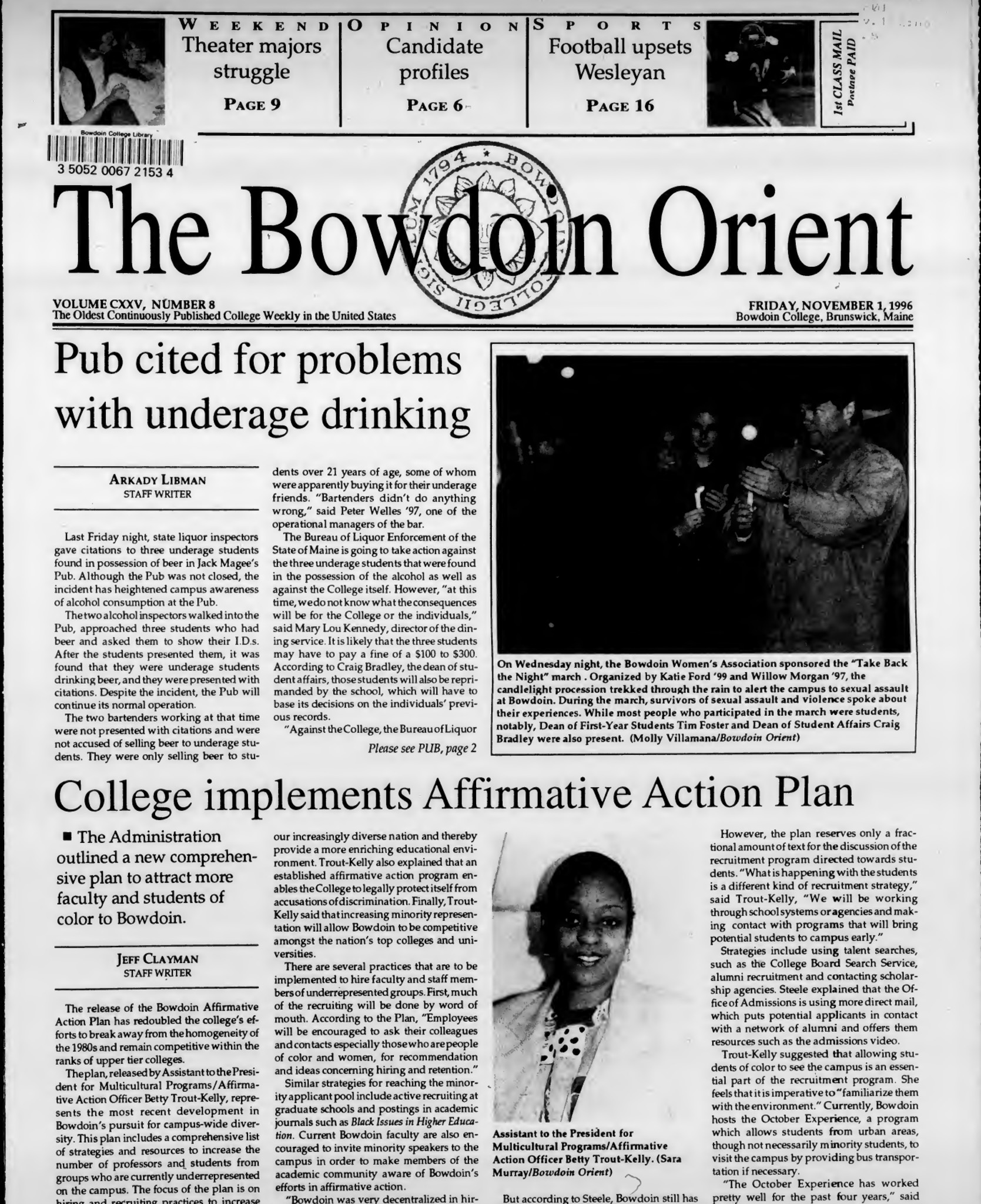November throughout Bowdoin’s history
November 21, 2025
 Courtesy of the George J. Mitchell Department of Special Collections
Courtesy of the George J. Mitchell Department of Special CollectionsAs the nation’s oldest continuously published college weekly, issues of the Orient dating back to 1871 are accessible in the College’s archives. This week, we looked back at past newspapers from the month of November to find memorable moments in Bowdoin’s history.
November 13, 1917: World War I impacts Bowdoin
American soldiers in World War I first saw combat in October 1917. Soon after, the Orient reported on how the “war to end all wars” was impacting campus.
“Now that the pressure of war is becoming felt more and more day by day, we begin to conjecture what the number of students would look like, if a new draw upon the number of men eligible for the draft and a call upon the coast patrol units should come,” the front page read, accompanied by the names of the students potentially subject to the draft.
Additionally, John Hay Beith, who served as a major in the British Army and fought on the Western Front from 1914 to 1916, delivered a speech in Brunswick that week titled “The Human Side of Trench Warfare.”
Meanwhile, the Orient’s editorial board accused Bowdoin students of ignorance regarding the war’s progress and urged greater engagement with the headlines.
“Our campus chatter runs on as usual, as it has run on ever since the war began,” the editorial board wrote. “We need not always be thinking of the war, but we should be sometimes thinking of it. Imagine the college men of 1940 envying us for living in such a momentous time, yet we do not appreciate what a momentous time this is?”
November 8, 1950: First-year students begin fraternity initiation “hell week”
While current college policies strictly prohibit hazing on campus, this 1950 issue cheerily profiled “hell week,” the last climax of hazing before first-year students were initiated into fraternities. The issue featured numerous pro-hazing takes in subsequent articles.
“Hell week” at Bowdoin was defined by the assignment of strange fraternity “quests” to pledges. The Orient noted that “the hazing committees on campus have been just as imaginative and diabolical as in years before” in the crafting of these tasks.
In 1950, the quests consisted of “the usual amount of visiting other colleges, especially girls’ schools,” the article wrote. “The objects of most of these quests seem to have been either freshman caps or ladies’ unmentionables.”
Other “hell week” shenanigans included students streaking the field at a Harvard-Holy Cross football game while carrying a Bowdoin banner, spending a day in Boston posing as beggars and being tasked to retrieve signatures from government officials throughout New England.
“To many people, these antics sound like the height of foolishness,” the article concludes. “Perhaps they are, but according to most comments on campus they are a lot of fun for freshman and upperclassmen alike. Taking place on the weekend as they do they cause little interference with the men’s studies, certainly no more than any weekend away from college, and they are among the memories which will loom strongest at the 25th reunion of the class.”
November 1, 1996: College implements new affirmative action plan
The landscape of higher education has been recently shaken by attacks on diversity, equity and inclusion and affirmative action programs. However, the political atmosphere was far more favorable to such programs in the 1990s. In 1996, the Orient reported on the new Bowdoin Affirmative Action Plan to attract more faculty and students of color to its predominantly white campus.
According to the article, the reasons for the new wave of initiatives were multiple. Attributed to former President of the College Robert Edwards was the position that “the primary issue … is to better students for our increasingly diverse nation and thereby provide a more enriching educational environment.”
Affirmative action programs were additionally supported by the administration as “[enabling] the College to legally protect itself from accusation of discrimination,” according to the article.
“Increasing minority representation will allow Bowdoin to be competitive amongst the nation’s top colleges and universities,” the article reads.
Planned strategies to attract more faculty members of color included active recruiting at graduate schools, postings in academic journals oriented towards non-white audiences and inviting more minority speakers to campus.
Strategies to attract students included talent searches, alumni recruitment efforts, contacting scholarship offices and increasing direct mail.
November 1, 2021: Jes Staley ’79 P’11 resigns from the Board of Trustees
President Donald Trump recently signed a bill to release the complete Jeffrey Epstein case files. In 2021, Bowdoin experienced its own Epstein-related controversy. The Orient reported that James “Jes” Staley ’79 P’11 stepped down from Bowdoin’s Board of Trustees following an announcement that he would also resign his position as the CEO of Barclays.
The article highlighted that he had “come under fire in recent years for his relationship with the late sex trafficker and financier Jeffrey Epstein, as well as accusations of misconduct during his time at Barclays.” Staley had served on Bowdoin’s board since 2007.
The announcement was noted to have followed “an aggressive student-led campaign demanding Staley’s resignation from the College’s board.” This included a petition calling for his removal and a teach-in during Family Weekend “detailing the extent of his wrongdoing.”

Comments
Before submitting a comment, please review our comment policy. Some key points from the policy: